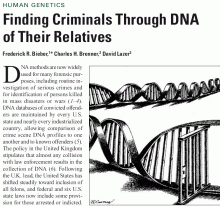Finding Criminals Through DNA of Their Relatives
DNA methods are now widely used for many forensic purposes, including routine investigation of serious crimes and for identification of persons killed in mass disasters or wars (1–4). DNA databases of convicted offenders are maintained by every U.S. state and nearly every industrialized country, allowing comparison of crime scene DNA profiles to one another and to known offenders (5). The policy in the United Kingdom stipulates that almost any collision with law enforcement results in the collection of DNA (6). Following the U.K. lead, the United States has shifted steadily toward inclusion of all felons, and federal and six U.S. state laws now include some provision for those arrested or indicted. At present, there are over 3 million samples in the U.S. offender/arrestee state and federal DNA databases (7). Statutes governing the use of such samples and protection against misuse vary from state to state (8).
Although direct comparisons of DNA profiles of known individuals and unknown biological evidence are most common, indirect genetic kinship analyses, using the DNA of biological relatives, are often necessary for humanitarian mass disaster and missing person identifications (1, 2, 9). Such methods could potentially be applied to searches of the convicted offender/arrestee DNA databases. When crime scene samples do not match anyone in a search of forensic databases, the application of indirect methods could identify individuals in the database who are close relatives of the potential suspects. This raises compelling policy questions about the balance between collective security and individual privacy (10).

